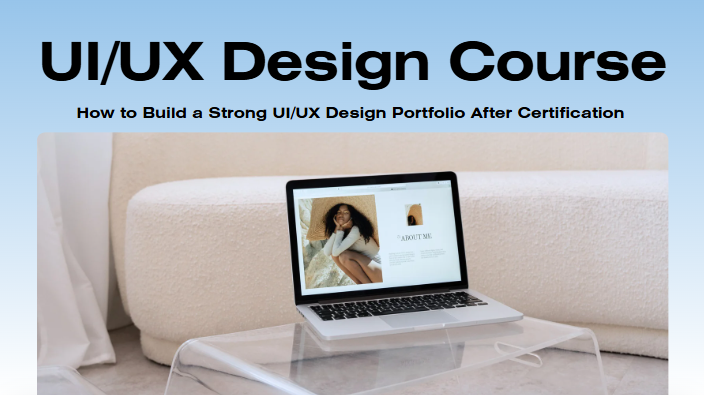
In the competitive field of UI/UX design, a great portfolio is vital for sticking out. If you’ve recently completed a UI/UX Design Course, whether online or in person, the next step is to create a convincing portfolio to demonstrate your abilities. A well-crafted portfolio showcases your ability to create user-centric experiences while also successfully communicating your thought process. This guide will assist you in developing a good UI/UX portfolio after receiving your Certificate in UI UX, whether through an online UI UX Design certification course or in a traditional classroom setting.
1. Understand the Purpose of Your Portfolio
Your UI/UX portfolio is a visual CV that highlights your strengths, inventiveness, and capacity for problem-solving. It should display your best work, demonstrate your design thinking process, and represent your own brand. Hiring managers and clients want designers that can create intuitive, aesthetically beautiful, and practical designs.
If you have finished an Advanced Certificate in UI UX, your portfolio should highlight your real-world projects and your capacity to apply theoretical knowledge.
2. Select Your Best Projects
New designers frequently make the error of putting all of their work in a portfolio. Instead, prioritize quality over quantity. Choose 4-6 of your greatest projects that exhibit a variety of talents, including:
- User research
- Wireframing and prototyping
- Visual design
- Interaction design
- Usability testing
Make sure to mention any projects you worked on throughout your education if you have earned an online UI Design or UX Design certification. However, consider expanding your portfolio by taking on freelancing assignments, reworking existing items, or working on personal projects.
3. Showcase Your Design Process
Clients and recruiters are more interested in how you came up with your solutions than they are in the finished designs. A solid UI/UX portfolio should chronicle the design process, including:
- Problem statement
- User research and insights
- Wireframes and prototypes
- Design iterations
- Usability testing and feedback
- Final design solution
By outlining your method in detail, you show that you can think critically and create with consumers in mind.
4. Create Case Studies
Without thorough case studies, a UI/UX portfolio is lacking. Each project should have a dedicated page or section where you may describe your design journey. Ensure your case studies include:
- Project Overview: A concise summary of the project, including the client (if applicable) and problem statement.
- Research and Strategy: Research findings, user personas, and how they affected your design choices.
- Wireframes and Prototypes: These are drawings, wireframes, and prototypes that demonstrate your methodology.
- Final User Interface Design: Interactive prototypes and high-fidelity mockups.
- Results & Takeaways: Important lessons learned and the ways in which the project affected users or corporate objectives.
You can use assignments from your curriculum as case studies if you’ve taken UX design certification classes, as long as they’re presented professionally.
5. Build a Personal Brand
The distinctive design viewpoint you possess is reflected in your UI/UX portfolio. To create a strong personal brand:
- Make use of a standardized layout, font, and color palette.
- Make a logo or identity for your personal brand.
- Create an engaging bio that emphasizes your experience, abilities, and goals.
If you have completed a UI/UX design course, describe how your education shaped your design philosophies and abilities.
6. Choose the Right Platform
You should be able to simply access your portfolio online. Consider hosting it at:
- Personal Website (Wix, WordPress, Webflow, or custom-coded)
- Platforms for portfolios (Dribbble, Behance)
- UX-specific platforms (UXfolio and Adobe Portfolio)
It’s possible that you were already introduced to platforms that can showcase your work if you finished an online design course.
7. Gain Real-World Experience
To differentiate your portfolio, acquire practical experience by:
- Freelance work
- Volunteer projects for non-profits
- Internships or apprenticeships
- Design challenges (UX Hackathons, 100 Days of UI Challenge)
Look for chances to use your talents in practical situations, even if your only study is from a UI design certification course.
8. Keep It Updated
Your portfolio should evolve as your talents improve. Update it frequently with fresh initiatives, enhance previous case studies, and polish your delivery.
After completing an online course for certification in UI/UX Design, keep learning by taking on new tasks and keeping abreast of market developments.
9. Seek Feedback and Iterate
Consult with expert designers before applying for jobs or freelancing work. Join UI/UX forums on LinkedIn, Slack, and Discord, and request portfolio reviews. Constructive feedback will help you enhance your portfolio and make it more effective.
10. Optimize for Job Applications
After finishing a UI/UX design course, you can apply for jobs by customizing your portfolio to fit the position.
- Emphasize projects that are pertinent to the job description.
- Create case studies that highlight the talents that companies are looking for.
- Make sure your portfolio is mobile-friendly and easy to access.
Enrolling in a UI/UX Design Course in Pune
If you are just getting started and looking for a UI/UX design course in Pune, there are numerous reputable institutes that provide thorough degrees. These courses offer hands-on training, mentorship, and networking opportunities, allowing you to lay a solid foundation before beginning your career in UI/UX design.
UI/UX Design Course in Mumbai – A Great Learning Opportunity
Enrolling in a UI UX design course in Mumbai might be an excellent approach for Mumbai residents to get industry-relevant skills. Mumbai’s design ecosystem provides valuable exposure, workshops, and access to seasoned designers who can help you establish a strong UI/UX design portfolio.
Conclusion
Following certification, developing a solid portfolio of UI/UX designs is essential for landing freelancing clients and employment prospects. Whether you have an Advanced Certificate in UI UX or an online UX Design certification, a well-organized and visually appealing portfolio will help you stand out in the industry. Focusing on case studies, practical projects, and ongoing development can help you build a portfolio that not only highlights your abilities but also shows that you can successfully address customer concerns.


